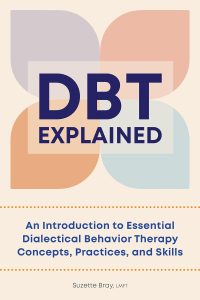It never made sense to me, DBT – dialectical behavior therapy. Where was the conflict? That and many other mysteries were solved by DBT Explained: An Introduction to Essential Dialectical Behavior Therapy Concepts, Practices, and Skills. Marsha Linehan’s discovery in DBT is well validated as a treatment. But what makes it special?
A Tale of Two Approaches
Cognitive behavioral therapy (CBT) has been well validated for a while, but its focus on changing the way one thinks sometimes left Linehan’s patients feeling invalidated for who they were at that moment. The insight was the introduction of an acceptance-based approach with meditation and mindfulness. In this way, DBT validates where the person is – and provides them with the skills and motivation to change. This is the essential, two-in-one conflict that is represented by the word “dialectical.” On the one hand, we accept the person for where they are, and on the other, we hope that they can change to better and healthier approaches.
It’s important to note that Motivational Interviewing solved the same dual nature differently. It focuses on understanding the person and accepting their current reality before moving on to focusing on the core challenges, evoking a desire to change, and planning for that change. It solves the acceptance problem by introducing the concept of understanding with acceptance.

Acceptance
Most people know the short version of the serenity prayer by Reinhold Staudinger. Most don’t know that it continues with, “Living one day at a time, Enjoying one moment at a time, Accepting hardship as the pathway to peace, Taking, as He did, this sinful world as it is, not as I would have it…” Here, the word “accepting” is used in conjunction with hardship, but the concept is included in a broader sense when we consider that we must accept the world the way it is.
Embedded are the concepts of willfulness, when we refuse to accept reality, and willingness, when we’re able to accept “the cards we’re dealt.” There’s a place for willfulness as we’re seeking to change the world, but in the present moment, denying reality does nothing to change it.
Acceptance of a person and their current reality is the essential first step to coming into alignment with them. You can’t tell someone how to achieve changes in their life without knowing where they’re starting from. (See also Richo’s How to Be an Adult in Relationships for more on acceptance.)
Emotional Regulation
Core to DBT is the improvement of emotional regulation. I struggle here, because “emotional regulation” isn’t quite the right language. It’s not that we prevent emotions from happening. It’s that we can learn to let them control us less.
In Daniel Goleman’s immensely popular Emotional Intelligence, he characterizes emotional intelligence along two axes splitting into four quadrants. On the first axis, we have awareness on one side and management on the other. The other axis is self and other. For both, awareness is required before management can begin. (See also Emotional Intelligence 2.0 and Primal Leadership.)
Beyond awareness comes the management piece, which is as much a negotiating process where emotions are evaluated for their utility by cognitive processes. This is at the heart of CBT as well.
The awareness step can be difficult for people, because they’ve learned that their emotions are scary and uncontrollable. Thus, they’ve blocked out all sense of emotions and live without conscious awareness of them – even though they’re silently controlling situations. (See Switch and The Happiness Hypothesis for Elephant-Rider-Path.) Often, once people can accept and acknowledge their emotions, the management of the emotions becomes a relatively easy set of skills to be taught.
Follow Your Heart
Many people in many different contexts offer the advice to follow your heart. Mostly, this means to follow your emotions and intuition towards your goals. “Following your heart” uncouples you from the realities that tend to hold you back and make it difficult to take big risks. This has its place and can be a powerful way to realize your dreams. It’s also dangerous to radically decouple from reality. It makes you susceptible to your feelings leading you astray.
I trained as a pilot decades ago. They taught us that when your instruments and your feelings differ, trust your instruments. Instruments all have backups to verify with, and if they’re telling you the same thing, then that’s what is happening – regardless of how you feel. It’s okay to fly by feel for a little bit, but you’ve got to remember to periodically check your instruments. You’ve got to check in with reality and make sure that what you feel is what’s really happening.
It’s like the Stockdale paradox that Jim Collins discusses in Good to Great. You need to follow your heart – have unwavering confidence – and you need to check things against reality – accept input when the situation dictates it.
In the end, if you want to navigate these sorts of paradoxes, it might be good to start by getting DBT Explained.


No comment yet, add your voice below!